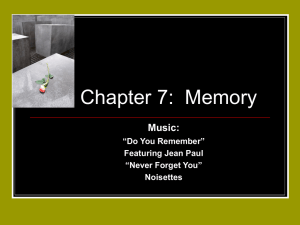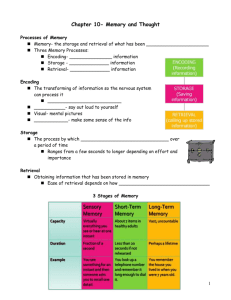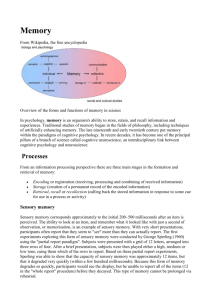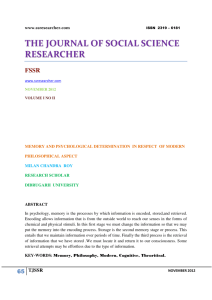Chapter Nine: Memory
advertisement
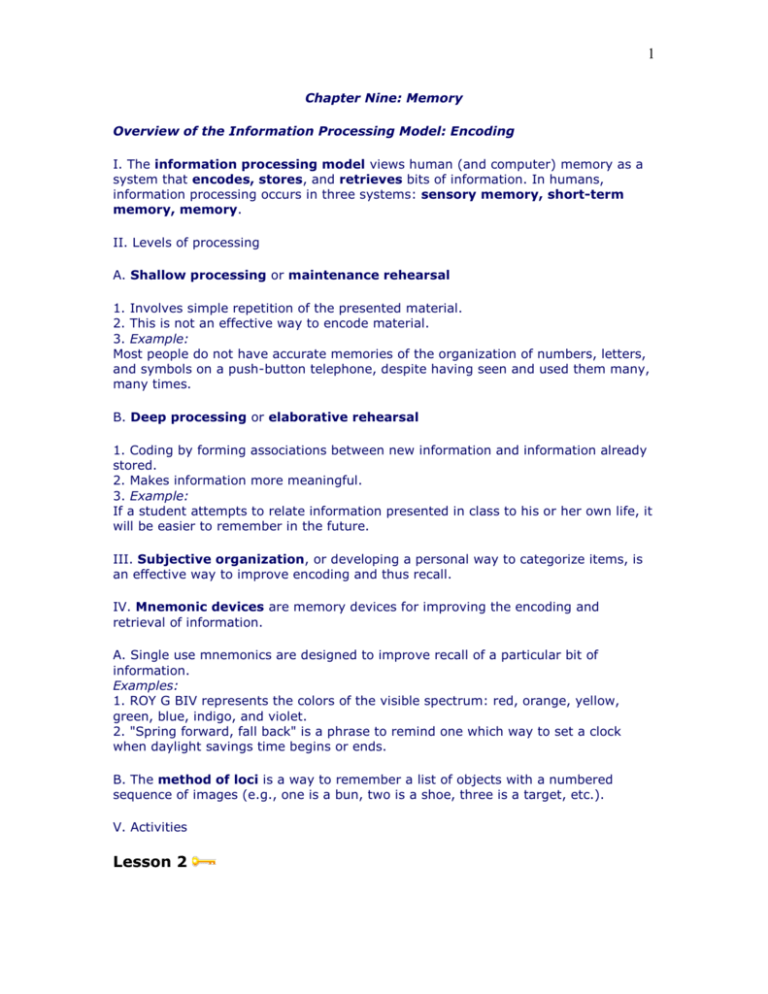
1 Chapter Nine: Memory Overview of the Information Processing Model: Encoding I. The information processing model views human (and computer) memory as a system that encodes, stores, and retrieves bits of information. In humans, information processing occurs in three systems: sensory memory, short-term memory, memory. II. Levels of processing A. Shallow processing or maintenance rehearsal 1. Involves simple repetition of the presented material. 2. This is not an effective way to encode material. 3. Example: Most people do not have accurate memories of the organization of numbers, letters, and symbols on a push-button telephone, despite having seen and used them many, many times. B. Deep processing or elaborative rehearsal 1. Coding by forming associations between new information and information already stored. 2. Makes information more meaningful. 3. Example: If a student attempts to relate information presented in class to his or her own life, it will be easier to remember in the future. III. Subjective organization, or developing a personal way to categorize items, is an effective way to improve encoding and thus recall. IV. Mnemonic devices are memory devices for improving the encoding and retrieval of information. A. Single use mnemonics are designed to improve recall of a particular bit of information. Examples: 1. ROY G BIV represents the colors of the visible spectrum: red, orange, yellow, green, blue, indigo, and violet. 2. "Spring forward, fall back" is a phrase to remind one which way to set a clock when daylight savings time begins or ends. B. The method of loci is a way to remember a list of objects with a numbered sequence of images (e.g., one is a bun, two is a shoe, three is a target, etc.). V. Activities Lesson 2 2 Sensory Memory and Short-Term Memory I. Sensory memory (also called sensory register) A. A very brief memory for sensory information. B. Allows us a very short period of time to review the overwhelming amount of sensory information. Most information is discarded, but some is selected for more extensive rehearsal. C. Visual sensory register 1. Maintains an image of what we have seen for a few tenths of a second after the stimulus has appeared. This kind of memory is called iconic. 2. Original research in this area involved the partial report technique developed by George Sperling in the early 1960s to test subjects’ recall of letters presented in a matrix. D. Auditory sensory register maintains the sounds we have heard for about 3 or 4 seconds after the stimulus; this kind of memory is called echoic. II. Short-Term memory (also called working memory) A. A limited, relatively brief storage system that holds items we are aware of and working with at any given time. B. Experiments indicate the duration of short-term memory is limited to about 18 seconds unless the subject rehearsed the information, in which case it is maintained in short-term memory indefinitely. C. Capacity of short-term memory 1. About seven items can be maintained in short-term memory if the information was encoded acoustically. 2. The information held in short-term memory can be increased if it is organized into chunks of meaningful or well-practiced information. Lesson 3 Serial Position Effects and Long-Term Memory I. Serial position effects. Our memory for a list of items tends to be better for items at the beginning or the end of the list and worse for items in the middle of the list. A. The primacy effect is the enhanced ability to recall items from the beginning of the list. B. The recency effect is the enhanced ability to recall items from the end of the list. II. Long-Term Memory 3 A. Our most permanent memory store, with almost unlimited capacity and duration. B. Types of long-term memories (Endel Tulvig) 1. Episodic memories are those for personally experienced events, such as what you had for breakfast this morning. 2. Semantic memories are for general factual knowledge, such as the temperature at which water boils. 3. Procedural memories are those that relate to skills or habits, such as your memory of how to brush your teeth. C. Explicit and implicit memories 1. Explicit (or declarative) memories are those of which one is consciously aware. Example: I may have an explicit memory of playing a particular golf course. 2. Implicit (or non-declarative) memories are those of which one is not conscious. Example: One may have implicit memories of how to tie one’s shoe but not be able to describe to another how to do it. Lesson 4 Retrieval I. Reconstructive memory A. The process of piecing together memories by fitting them to a meaningful plan or organization. B. Accounts for much of the inaccuracy of our recollections. We fill in gaps with assumptions because we are uncomfortable with the gaps. Once we’ve done this, distinguishing what actually happened from what we filled in is almost impossible. II. Context A. You recall more accurately in the same situation where the event originally took place. B. Similar contexts may trigger feelings of deja vu. III. State-dependent memory is the improved retrieval of material when one is in the same mental, emotional, or drug-induced state that was present when the material was originally learned. IV. Eyewitness testimony The work of Elizabeth Loftus and others has identified several aspects of eyewitness testimony. A. The accuracy of eyewitness testimony can be influenced by the way questions are phrased. 4 B. Children are particularly susceptible to having false memories planted. C. There is little correlation between witness certainty and witness accuracy. In other words, witnesses who believe they are correct are no more likely to be correct than witnesses who are not sure. Lesson 5 Forgetting and the Biology of Memory I. Forgetting A. Decay theory 1. Argues that forgetting is caused by the passage of time. 2. No physiological mechanism to account for decay has been identified. B. Interference theory 1. Argues that retrieval failure occurs when established associations conflict with what we are trying to recall. 2. Types. a. Proactive interference occurs when previous learning decreases your ability to remember more recently learned material. For example, proactive interference occurs if you can’t remember the name of the new assistant principal because all you can think of is the name of the former assistant principal. b. Retroactive interference occurs when recently learned material decreases your ability to remember older material. For example, retroactive interference occurs if you can’t remember the team that won last year’s World Series because all you can think of is the team that won the Series this year. C. Repression theory 1. Sigmund Freud argued that painful memories are self-censored and stored in the unconscious mind. 2. The extent to which repression occurs is controversial. II. Biology of memory A. Cerebellum 1. Richard Thompson has found that a classically conditioned eye blink response in rabbits stopped after a small area of the cerebellum was lesioned. 2. Evidence suggests that implicit memories are stored in the cerebellum. B. The hippocampus seems to be where explicit memories are processed.

